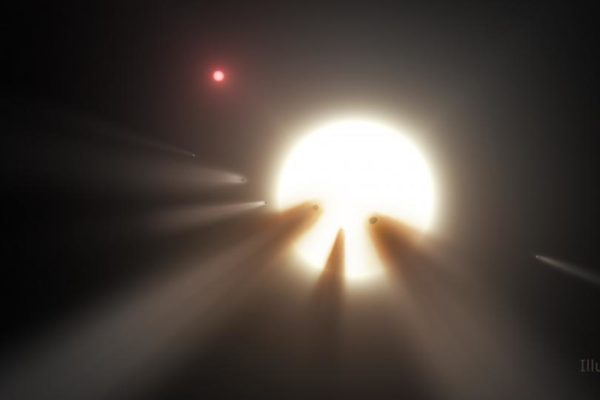
Astronomy researchers have announced that the distant Star labeled KIC 8462852, also known as ‘Tabby’s Star’ has been dimming over the years.
KIC 8462852 was observed as early as the year 1890. In 2009, NASA launched the Kepler Spacecraft to observe the Earth-size planets orbiting other stars. The Kepler Spacecraft succeeded in bringing new data on KIC 8462852. The star was later named after the American astronomer Tabetha Suzanne Boyajian from Yale University. Tabetha has been the leader of a group of astronomers analyzing the data on the star brought by the Kepler Spacecraft.
The star is said to be located in the Cygnus constellation, about 1,480 light years from Earth. Light years is a unit of length used informally to express astronomical distances. One light year is approximately 9 trillion kilometres.
In 2015, Tabetha and her team reported that based on observations they conducted using the Kepler Space Telescope between 2009 and 2013, they discovered two unusual incidents in 2011 and 2013 about the star. The team said they discovered that the star’s light has been dimming in a dramatic way never seen before.
The team theorized that the dimming indicated that something had passed in front of the star in the constellations, Cygnus and Lyra. When this was theorized, some astronomers came out with more explanations to the possible dimming of the star. Some said a swarm of comets is likely to be blocking the light of the star.
The astronomer, Jason Wright from Penn State University even suggested strongly that the swarm of objects around the star was built by an alien civilization. This led the whole debate back to the issue of alien life.
As this debate is still ongoing, a new study recently published on the star has deepened the mystery. which the astronomers claimed to be using empirical and rational methods to explain.
The current study has confirmed that the star has been dimming continuously within the four years the researchers spent studying it. The study has been accepted in the Electronic Print of Scientific Papers Arxiv. The study is yet to be peer reviewed. The researchers used the Kepler Space Telescope’s database during its mission from 2009 to 2013, to measure light or lack thereof, from the star. They found that the star has dimmed constantly over the observation period.
New paper on Arxiv regarding KIC8462852. It remaining as mysterious as ever: https://t.co/xjejuCmwu8 #space #unknown pic.twitter.com/JgzutHVDaR
— LittlePlanetFactory (@planetforgium) August 5, 2016
Lead researchers of the study, Ben Montet and Joshua Simon recorded a slight decrease in light from the star at first, before a dramatic plummet of 2.5 percent in just 200 days, after which the drop in light returned to a steady fade.
For context, the astronomers compared the star to 500 stars in the same region, and 500 other stars that are of a similar size and makeup. They found that none of those examined came close to resembling the star’s plummet in brightness.
Montet told Gizmodo in an interview that when the team made the discovery, they could not believe what they saw. He was quoted as saying: “The part that really surprised me was just how rapid and non-linear it was. We spent a long time trying to convince ourselves this wasn’t real. We just weren’t able to.”
Looks like KIC 8462852 #TabbysStar really is dimming; lends weight to Schaefer!https://t.co/rAIIPd6ID8 pic.twitter.com/9ZP5HKPnOP
— Tony Jebson (@ajebson) August 5, 2016
Commenting on this new study, the astronomer Keivan Stassun, who has also spent years studying the light patterns of the star, said the findings of the study show that the mystery surrounding the star cannot be easily explained.
“Tabby’s star continues to defy easy explanation. These intriguing new findings suggest that none of the considered phenomena can alone explain the observations. Of course, the star doesn’t have to abide by our hope for a single explanation. In the end, figuring out this puzzle may require accounting for a combination of effects,” Stassun told Popular Science.
Despite the controversy and the mystery, astronomers say they will continue to monitor KIC 8463852 to determine what exactly is causing its erratic behavior. The RT English News reports that the Kepler spacecraft is no longer available, and that astronomers will have to wait for the TESS telescope, which is expected to be launched in 2017.
You want to support Anonymous Independent & Investigative News? Please, follow us on Twitter: Follow @AnonymousNewsHQ
This Article (Mystery of ‘Alien Megastructure’ Star Deepens After New Study Confirmed Erratic Dimming) is free and open source. You have permission to republish this article under a Creative Commons license with attribution to the author and AnonHQ.com








What an utter load of scientifically (not to mention literally) illiterate nonsense.